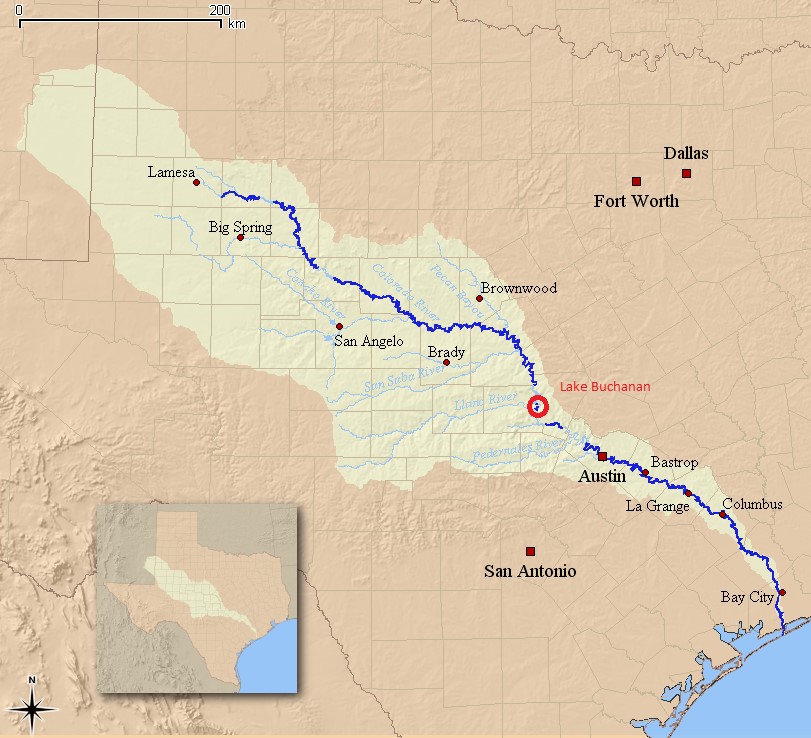Old Bluffton

Old Bluffton was originally the homestead of the Davis family who had moved there in the 1850s, resettled from Bluffton, Arkansas. The small Texas town that emerged became a stop on a stagecoach line. Located along the Colorado River, it was bottomland with pecan orchards, cotton fields, cornfields, and pasture. The town grew modestly with the opening of a saltworks and cotton gin. Given its location near several Colorado River crossings it supported a blacksmith shop, hotel, and saloon among other businesses.[2]
Most physical reminders of Old Bluffton disappeared after the eminent domain takeover and inundation in 1938. Under 20 feet of water, Old Bluffton was out of view and only the subject of historians. However, the drought of the past decade dropped the water level and revealed what many now refer to as the Old Bluffton “ghost town.” Once again visible old structures and even grave stones brought the displaced town’s history back into the public eye after 75 years out of sight. As more and more was revealed by the receding water, more and more attention was paid to local historians and residents who had knowledge of Bluffton’s past.


Alfred Hallmark, a local historian whose great-great-great grandfather Billy Davis established Old Bluffton in 1854,reflects on his family and the town’s history.
"So my great-great-great grandfather was over in the Georgetown area, Williamson County, so he brought his family to the west side of the Colorado River in 1854 to the Bluffton site primarily so they could work with [Davie] Cowan in the salt works business. And that’s basically why they came here to start with. They settled on 640 acres. If you look at the maps of that area you’ll see that the Colorado River makes a horseshoe bend there and his family homesteaded that 640 acres and that became their basis for where they lived."
Another current resident, Karon Milam, whose family owns a local charter fishing business along Lake Buchanan, looks back on her family history in Old Bluffton:
"About the farthest back I know of our family here is about 5 or 6 generations back. It seems like they kind of came here where we are and farmed near the river bottom. It seems like they were mainly farm workers and sharecroppers. I don't think that they themselves owned any of that property down in there. If they did it was probably small parcels, kind of like most people in those days, pretty much everybody, looking at the censuses, everybody was pretty much a family farmer. Everybody had big families and worked out in the field growing a good garden, raising livestock to support their family."
"I know that my grandpa was still involved with that kind of stuff as a kid before the lake because I got all excited once about finding an arrowhead as a kid and he was like, "that's no big deal, they are all over the place up there." He said that he used to come in from plowing the fields out there, and he pointed to where I had been, he came in from plowing the fields and he had a pile of them by the wagon bed and I would empty the arrowheads from my pockets and toss them in the pile. I asked him where the pile was now and told me that it's under about 20 feet of silt now and that I would never ever find it."
As is the case with other eminent domain sites, the community retains a collective historical memory of the loss of the physical community even decades after it had disappeared. Karon Milam met an older gentleman one day, standing and looking out over the drought-stricken and dried up Lake Buchanan:
"He was standing there and he pointed out a place where the treetops were sticking up out there and he was just like, "that big tree there just to the right of it was where our home was." He told me about what it was like for his family because apparently they were land owners and their big family just pretty much dispersed all over the state when their land was lost and some of them ended up in Ft. Worth which I guess for a lot of people, I know that a lot of my family ended up in San Angelo to find work and stuff like that and some moved up to Dallas to find work."
“But the old man, kind of the way he talked about it and everything, you could tell that it was pretty deep wound. You could tell that it really hurt to have to give up the lifestyle that they had grown up with and all that they had ever known for generations. I always got the feeling that people just didn't talk about it because I think that it hurt them a lot. You know, I'm sure it did, it had to. They had to move the school, churches, because the town center had to be moved a out of the lake basin and of course those buildings got moved to other places and they are still standing in another location, but you think about uprooting a town from where it began and where it had been for awhile that doesn't even begin to touch on all of the homesteads and stuff like that and you don't even really think about them ever being there until you are walking on a beach and you find a piece of crockery that was somebody's old mixing bowl or part of a teacup."
[1] Wikipedia: https://en.wikipedia.org/wiki/Colorado_River_%28Texas%29.
[2] Uncovered Texas, “Bluffton Ghost Town” Uncovered Texas web site. http://www.uncoveredtexas.com/texas-ghost-town-detail.php?city=Bluffton&county=Llano Accessed January 18, 2016.
[3] Fox7 (TV Austin), N.D. Photographs. Old Bluffton Grocery and Old Bluffton Blacksmith. http://www.myfoxaustin.com/story/18283976/old-bluffton-resurfacing-in-drought. Accessed June 3, 2015.

